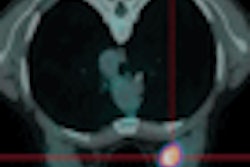
NEW YORK (Reuters Health), Nov 18 - Recent findings published in the November issue of the journal Gut suggest that there are identifiable subsets of patients with Crohn's disease who are at risk of exposure to high levels of diagnostic radiation.
"Protracted exposure to low-level ionizing radiation, including diagnostic radiation, is widely believed to be associated with an increased incidence of malignancy," Dr. F. Shanahan, of National University of Ireland, Cork, and colleagues point out. "Diagnostic imaging is frequently essential for patients with Crohn's disease at initial diagnosis, for monitoring response to therapy, and for perioperative evaluation."
The researchers examined patterns of imaging use for 354 patients with Crohn's disease and quantified the cumulative effective dose of diagnostic radiation they received. The team also identified patients at the greatest risk of exposure to high levels of diagnostic radiation.
The authors calculated the cumulative effective dose retrospectively from imaging performed between July 1992 and June 2007. High exposure was defined as a cumulative effective dose exceeding 75 mSv. This exposure level has previously been shown to increase cancer mortality by 7.3%.
The mean cumulative effective dose received in the first five years was 7.9 mSv, with patients undergoing a mean of 5.6 imaging studies. In the last five years of the study, the patients underwent a mean of 6.9 imaging studies, and the mean cumulative effective dose of diagnostic radiation rose to 25.1 mSv.
Over the study period, the use of CT imaging increased significantly and accounted for 77.2% of diagnostic radiation. The mean cumulative effective dose per patient was 36.1 mSv, and in 15.5% of the subjects, it exceeded 75 mSv.
Risk factors significantly associated with high exposure levels included age younger than 17 years; upper gastrointestinal tract disease; penetrating disease; and use of oral steroids, intravenous steroids, or infliximab.
Patients who underwent their first surgical procedure for Crohn's disease during the study period and those who required more than one surgery were also more likely to receive a high cumulative effective dose (p < 0.001 for both).
"Seven patients developed malignancies during the study period, resulting in two deaths (two cutaneous basal cell carcinomas, two cutaneous squamous cell carcinomas, one Dukes' B colonic carcinoma, one fatal case of B cell lymphoma of small bowel, and one fatal case of metastatic melanoma)," Shanahan and colleagues report.
The patients' mean cumulative effective radiation dose received at malignancy diagnosis was 29.9 mSv. Radiation dose exceeded 75 mSv in only one patient, who was 74 years old and developed a cutaneous squamous cell carcinoma.
Based on these findings, and the fact that Crohn's disease is lifelong and usually diagnosed early in life, the researchers recommend the development of low-dose radiation imaging protocols for these patients.
Gut 2008;57:1524-1529.
Last Updated: 2008-11-17 13:18:41 -0400 (Reuters Health)
Related Reading
CT enterography can determine Crohn's disease severity, November 7, 2006
Copyright © 2008 Reuters Limited. All rights reserved. Republication or redistribution of Reuters content, including by framing or similar means, is expressly prohibited without the prior written consent of Reuters. Reuters shall not be liable for any errors or delays in the content, or for any actions taken in reliance thereon. Reuters and the Reuters sphere logo are registered trademarks and trademarks of the Reuters group of companies around the world.


















